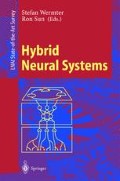Abstract
Context Vectors are fixed-length vector representations useful for document retrieval and word sense disambiguation. Context vectors were motivated by four goals:
-
1
Capture “similarity of use” among words (“car” is similar to “auto”, but not similar to “hippopotamus”).
-
2
Quickly find constituent objects (eg., documents that contain specified words).
-
3
Generate context vectors automatically from an unlabeled corpus.
-
4
Use context vectors as input to standard learning algorithms.
Context Vectors lack, however, a natural way to represent syntax, discourse, or logic. Accommodating all these capabilities into a “Grand Unified Representation” is, we maintain, a prerequisite for solving the most difficult problems in Artificial Intelligence, including natural language understanding.
Access this chapter
Tax calculation will be finalised at checkout
Purchases are for personal use only
Preview
Unable to display preview. Download preview PDF.
References
Caid, W.R., Dumais, S.T., Gallant, S.I.: Learned vector space models for docu- ment retrieval. Information Processing and Management 31(3), 419–429 (1995)
Caid, W.R., Pu, O.: System and method of context vector generation and retrieval. United States Patent 5619709, November 21 (1995)
Deerwester, S., Dumais, S.T., Landauer, T.K., Furnas, G.W., Harshman, R.A.: Indexing by latent semantic analysis. Journal of the Society for Information Science 41(6), 391–407 (1990)
Dumais, S.T.: Improving the retrieval of information from external sources. Behavior Research Methods, Instruments and Computers 23(2), 229–236 (1991)
Dumais, S.T.: LSI meets TREC: A status report. In: Harman, D. (ed.) The First Text REtrieval Co nference (TREC-1). NIST special publication 500-207, pp. 137–152 (1993)
Dumais, S.T.: Latent Semantic Indexing (LSI) and TREC-2. In: Harman, D. (ed.) The Second Text REtrieval Conference (TREC-2). NIST special publication 500-215, pp. 105–115 (1994)
Furnas, G.W., Deerwester, S., Dumais, S.T., Landauer, T.K., Harshman, R.A., Streeter, L.A., Lochbaum, K.E.: Information retrieval using a singular value decomposition model of latent semantic structure. In: Proceedings of SIGIR, pp. 465–480 (1988)
Gallant, S.I.: Perceptron-based learning algorithms. IEEE Transactions on Neural Networks 1(2), 179–192 (1990)
Gallant, S.I.: Context vector representations for document retrieval. In: AAAI-1991 Natural Language Text Retrieval Workshop, Anaheim, CA (1991)
Gallant, S.I.: A practical approach for representing context and for performing word sense disambiguation using neural networks. Neural Computation 3(3), 293–309 (1991)
Gallant, S.I.: Neural Network Learning and Expert Systems. MIT Press, Cambridge (1993)
Gallant, S.I.: Method For Document Retrieval and for Word Sense Disambiguation Using Neural Networks. United States Patent 5, 317–507 (1994)
Gallant, S.I.: Method For Context Vector Generation for use in Document Storage and Retrieval. United States Patent 5, 325–298 (1994)
Gallant, S.I., Caid, W.R., et al.: HNC’s MatchPlus system. The First Text REtrieval Conference: Washington, DC, pp. 107–111 (1992)
Gallant, S.I., Caid, W.R., et al.: Feedback and Mixing Experiments With MatchPlus. In: The Second Text REtrieval Conference (TREC-2). NIST special publication 500-215, pp. 101–104 (1993)
Gallant, S.I., Johnston, M.F.: Image retrieval using Image Context Vectors: first results. In: Niblack, Jain (eds.) Storage and Retrieval for Image and Video Databases III, IST/SPIE Symposium on Electronic Imaging: Science & Technology, SPIE, San Jose, Ca, February 5-10, vol. 2420, pp. 82–94 (1995)
Kohonen, T.: Self-Organizing Maps. Springer, Berlin (1995)
Plate, T.A.: Distributed Representations and Nested Compositional Structure. University of Toronto, Department of Computer Science Ph.D. Thesis (1994)
Salton, G., McGill, M.J.: Introduction to Modern Information Retrieval. McGraw-Hill, New York (1983)
Author information
Authors and Affiliations
Editor information
Editors and Affiliations
Rights and permissions
Copyright information
© 2000 Springer-Verlag Berlin Heidelberg
About this paper
Cite this paper
Gallant, S.I. (2000). Context Vectors: A Step Toward a “Grand Unified Representation”. In: Wermter, S., Sun, R. (eds) Hybrid Neural Systems. Hybrid Neural Systems 1998. Lecture Notes in Computer Science(), vol 1778. Springer, Berlin, Heidelberg. https://doi.org/10.1007/10719871_14
Download citation
DOI: https://doi.org/10.1007/10719871_14
Publisher Name: Springer, Berlin, Heidelberg
Print ISBN: 978-3-540-67305-7
Online ISBN: 978-3-540-46417-4
eBook Packages: Springer Book Archive

